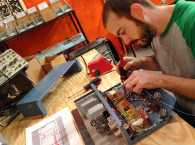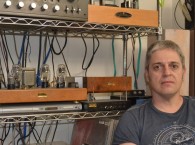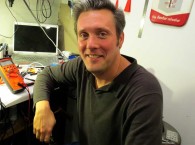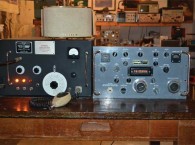Electrical Engineer Finds “Joy in Audio Electronics”

engineering career in 1966.
SHANNON BECKER:
CHUCK HANSEN: I have always lived in Monmouth County, NJ. I took college prep courses at Middletown High School, and I was fortunate that one of the high school guidance counselors found me a college we could afford. I graduated from Newark College of Engineering—now New Jersey Institute of Technology (NJIT)—with a BS in Electrical Engineering and took some grad courses at Fairleigh-Dickinson. My Dad and two uncles were tool and die makers, and my grandfather was an engineer. We all eventually retired from the same Bendix Red Bank division in New Jersey. My dad was very supportive of my interest in science and technology.
SHANNON: How did you become interested in audio electronics?
CHUCK: When I was a kid, I bought a book about the story of a boy who became interested in ham radio and got his license, built his own radio transmitter and receiver, and had all kinds of interesting adventures on the air. I never got a ham license, but it sparked (no pun intended) my interest in electricity, science, and electronics, and I do belong to the American Radio Relay League (ARRL).
When I was young, I built an AM radio kit that used a cap, a tunable slug inductor, and a germanium detector diode, with a transistor to drive headphones. With a wire antenna and ground, I was able to receive the larger AM stations in New York City. From that experience, I subscribed to as many electronics magazines as I could find (e.g., Radio Electronics, Popular Electronics, etc.). I kept modifying the audio amplifier section of the kit radio hoping it would sound better (but I didn’t perform any AB testing). I also took apart every dead radio and TV I could find, keeping the electronics parts for my “junk box.”
During high school summers, I worked for a German couple at a local amusement park. When they replaced their sound system in 1960 they gave me their old Telefunken AM receiver-amplifier and a wire recorder. I used the receiver-amplifier chassis for many electronic audio projects. My dad helped me build a nice cabinet for a donated turntable and a used Dynaco PAS-2 preamp. I built a 10-W stereo power amplifier, using a design from the RCA RC-19 tube manual, reusing the old Telefunken chassis. I used mediocre 4” and 8” Lafayette Radio drivers at each end of the cabinet. Later, we added a Pentron tape deck since the wire recorded wasn’t good for audio. I guess it would be a valuable antique now.
During college, I learned to play electric bass (just in time for the Beatles invasion). I built a guitar amplifier from a Gromes hi-fi amplifier kit, then made a speaker cabinet from plywood and two cheap 12” bass guitar loudspeakers. It worked fine as long as I didn’t expect to get any fundamental bass notes from the 41-Hz low E string. North Jersey was rich in jazz musicians, and I took jazz guitar lessons from some of the pro players, while playing bass in college rock bands to earn money for my tuition. I also worked college summers at the old Electronic Associates, in West Long Branch, NJ. It made precision analog computers and two-axis plotters. It even made its own precision film capacitors for the integrator and differentiator plug-in amplifier modules. I learned all I could about analog electronics from the engineers there.

electrical system in the
Bendix Systems Lab in 1968.
SHANNON: Describe your career as an electrical engineer and your work as a consultant in the aerospace industry.
CHUCK: I always worked in the electric power field, starting at Bendix Electric Power Division in 1966, working on 400-Hz aerospace power. My dad and two uncles had worked there since World War II. After a couple years, I headed up the electrical system test group for the new Boeing 747 jumbo jet, which had a 60-kVA generator on each of the four engines. The main AC system could be run isolated, in full-parallel, or split-parallel. Two independent 90-kVA generators were mounted on the auxiliary power unit (APU). It was the most complex aircraft electrical system ever designed at that time. I also designed the generator control units for the hydraulic-powered emergency generators used on the F-14 and F-15 fighters.
Back then, we had to use military-approved parts. There were no integrated circuits, so that meant all-discrete transistor designs. There were no MOSFETs, and the diffused-junction bipolar power transistors that were available were far too slow to switch the highly inductive exciter field with our generator voltage regulators. Not much was known about safe operating areas at the time. Bendix had its own semiconductor division, but it was more interested in small-signal transistors. To ensure high reliability, we used a very expensive Westinghouse gold-doped alloy Darlington transistor that, while slow, had a huge avalanche energy rating. I learned a lot about discrete analog design from the Bendix engineers who grew up in the vacuum-tube era.
Next, I went to work for PSEG, a New Jersey-based electric utility, in a newly formed group tasked to add gas-turbine generation units to the grid in the early 1970s to meet New Jersey’s increasing power demand. It took years to make a steam-generating plant, while the turnkey modular gas turbine units were a quick install. I designed a very accurate solid-state underfrequency unit that triggered selected fast-responding gas turbine units (64 MW in total) to go into what was termed “area regulation mode” to prevent loss of the system in the event of a transmission line overload.
This was in response to the 1965 Northeast Blackout, where loss of a generating station in Ontario, Canada caused cascading transmission line overloads that tripped off one power area after another down into the US. I also helped design the area regulation controller topology. Large steam-powered generators just can’t change load quickly enough to respond to system instabilities. The gas turbine area regulation control system gave the system the needed control algorithm to restore stability.
My next PSEG assignment was to head the Instrumentation and Controls section of the Salem Nuclear Generating Station Startup Group. Soon after we formed, we were caught up in the confusion during the Energy Reorganization Act of 1974, when the agency that had control over commercial nuclear power changed from the Atomic Energy Commission (AEC) to the Nuclear Regulatory Commission (NRC). The reorganization and rule changes delayed Salem by a few years and added greatly to the cost of Salem and every subsequent nuclear power project in this country, as I recall.
Next, I went to work for an erstwhile company in New York City that specialized in international nuclear power design. However, when the Three Mile Island accident occurred in 1978, I felt it was best to return to Bendix Electric Power Division. I became the Systems and Controls Supervisory Engineer. The company I left went out of business when nuclear power generation design and construction came to a virtual halt.
When analog and digital ICs first came out, we needed a lot of hand-holding and the IC manufacturer’s experts came to our rescue. I am indebted to many folks including: Bonnie Baker, James Bryant, Martin Giles, Gerald Graeme, Walt Jung, Walt Kester, Ron Mancini, Bob Pease, Jim Williams, and the others who guided me through the practical application of their company’s analog ICs. I was lucky enough to meet some of them in person at seminars held in New York and New Jersey venues.
Bendix was taken over by Allied Chemical in the late 1980s, which then became Allied-Signal (A-S) with the purchase of the Signal companies. I retired from A-S in 1998 when our division was moved to Tucson, AZ. A bit later A-S bought Honeywell and then took the Honeywell name.
I currently work for a small startup company that does work in the aerospace electric power field. The old Bendix/A-S/Honeywell plant in Eatontown, NJ is now a Lowes, ironically located right behind the building in which I now work. I design custom lab and calibration equipment and design all the current transformers we produce. I also participate in engineering design reviews, helping to ensure the analog designs and aircraft interfaces are robust and reliable.
SHANNON: Tell us about your first personal project.
CHUCK: My first personal project was the aforementioned AM radio kit. I built it when I received it as a Christmas present, with no idea how it worked. It is long gone. It probably came to grief from all my modifications. I replaced it in 1961 with a Lafayette transistor AM radio.
SHANNON: You have written two books for Audio Amateur and you have published more than 260 magazine articles. What compelled you to start writing? Are you planning to submit more articles to audioXpress?
CHUCK: First, a little back story: To ensure uniform design requirements for our electronic design engineers, I compiled the derating requirements from MIL-HDBK-217, MIL-STD-1547, DO-160, and all of our commercial aircraft customers’ standard parts manuals into one worst-case design requirements manual that could be used for every customer. We called it “Bendix Electrical/Electronic Parts Selection, Application and Derating.”
The first paid article I wrote was for the Gernsback publication Popular Electronics in 1980. It was based on the idea of high reliability through derating the voltage, current, and power applied to electronic parts, using the information I researched for the design requirement manual. “For Projects That Last—Derate Your Components” was published in Popular Electronics, January 1982. I wrote a total of 10 articles for Popular Electronics through 1998. In 2001, I wrote “Choosing and Using Electronic Parts: A Survival Guide,” a three-part expanded version of my derating article for audioXpress.
A colleague and I wrote feature articles about Bendix equipment for the Bendix Eatontown Output and the Local Focus newsletters at work. Then, to help the people in production test, I started writing documents that explained how our equipment worked and how to troubleshoot the various electronic units. I created schematics for the testers that were similar to the ones provided with Heathkits and Howard W. Sams PhotoFacts. They were well received and helped add objectivity to what they had termed “black magic” electronics testing.
I first got in touch with Ed Dell in 1997 to propose a preamp construction article based on the HeadRoom headphone amp module. Not only did he graciously accept an article from a perfect stranger, he came down to visit me a few months later. (His son Chad teaches at Monmouth University, and it turned out Chad was the faculty adviser for my niece’s future husband.) I utilized the chassis from my old Heathkit AA-1214 integrated amp. I adapted a Walt Jung design for the phono preamp section. My article appeared in the June 1997 issue of Audio Electronics, and thus began my long association with Ed Dell and The Audio Amateur (TAA), leading to almost 250 more articles, reviews, test reports, and “New Chips on the Block” article columns in the various TAA publications. Through TAA I have become friends with many of the true experts in the audio field, for which I am very grateful.
While my engineering background is primarily in aerospace electric power, audio is a synergistic fit for my work in analog design. During the time I served as the ad-hoc test editor for the Audio Amateur audio equipment reviews, digital audio was achieving higher and higher resolution, and it became clear that my modest 16-bit test equipment could no longer keep up with the rapid progress in audio technology. I learned a lot about audio testing from John Atkinson at Stereophile magazine, and the Audio Precision Audio.TST newsletters. It is also interesting to realize how far publishing has come since 1980, when I reviewed my first article from the print galleys. Now, we do everything on computers and submit articles by e-mail. More and more magazines are becoming online only and no longer provide print versions.
My most recent submission to audioXpress (February 2012) was a new book review, on Helmuth Lemme’s book, Electric Guitar—Sound Secrets and Technology (Elektor, 2012).
SHANNON: Are any of the designs that appeared in audioXpress still in use today?
CHUCK: Oh, yes, many of them are still in use since I sometimes wrote articles based on practical circuits I needed for a work application or my own lab. I also use much of the test equipment discussed in audioXpress articles and other electronic publications. Topics included: a multi-tone IM signal generator, a precision sine wave oscillator, a transformer polarity tester, audio passive loads, an audio balun, a semiconductor curve tracer, a noise meter amplifier, a phase meter calibrator, a power quality monitor (my current source for measuring loudspeaker impedance and phase versus frequency), the AES17 22-kHz low-pass filter for PWM audio amplifier tests, and oscilloscope calibrators.

I still use my HeadRoom-based preamp as my headphone amplifier, my modified Adcom GFP-55 II preamp, my modified Rotel RCD 970BX CD player, my modified Scott 222C tube-integrated amp, and my scratch-built LM3875 IC power amplifier with a quad-pod circuit
I also use the modified Peavey TKO-80 bass guitar amp that was the topic of a 2003 two-part audioXpress article, and I designed a simple modification for my Evans 80 Jazz Amp that minimizes the crossover distortion. Evans incorporated this change in the production amplifier boards starting in 2003. I really enjoyed our collaboration.
SHANNON: Tell us about your book, The Joy of Audio Electronics (Audio Amateur Publications, 1999). Why did you write it specifically for beginners? After 14 years, is there anything you would explain differently?
CHUCK: After I retired in 1998, Ed Dell asked me if I wanted to write a book for beginners who were interested in audio electronics. It took a number of false starts and rewrites before I was able to distill his concept into the book he published. Old Colony book sales were pretty slow so he contacted RadioShack to see if it might be interested in featuring the book on its in-store sales racks (Forrest Mimms did quite well with his notebooks and project designs in RadioShack stores). RadioShack wasn’t really interested in a book about such a narrow topic.
The other book I wrote for Audio Amateur was A Brief History of Bendix Red Bank Tubes. It started out as an article for Vacuum Tube Valley magazine, but it never got published for a variety of reasons. Ed obtained the rights to the article and had me expand it into the book in 2006. My grandfather and an uncle were vacuum tube engineers before the depression, and my father developed a lot of the specialized tooling at Bendix for the internal parts of the Red Bank tubes. Many of the employees who worked in the “tube section” were getting on in years, and I felt compelled to document as much about Red Bank tubes as possible while they and my family were still around. Much of the tube work was done for the military during the cold war, so there wasn’t a lot of public information available.
SHANNON: In your book, The Joy of Audio Electronics, you discuss setting up a workshop. Can you describe your own workshop?
CHUCK: My workshop lab is located in a spare bedroom, while I do the metal work and machining in my basement shop. I get lots of exercise running up and down the stairs when I am building a project. Most of my equipment is 1970s era HP, Fluke, and Tektronix, along with Heathkits that I have modified for improved performance. Then, there is also my home-brew test equipment.
If I find 1970s test equipment on eBay that is “untested, for spare parts,” I will buy it for the custom semiconductors that I might be able to use to repair my own equipment in the future. Tektronix used a custom dual JFET in its scope amplifiers that has a high- and low-transconductance JFET in the same multi-pin package. Those are just not available anymore. I have three Tektronix 7603 oscilloscopes (two are not fully functional) and lots of 7000-series plug-ins. I also collect Tektronix TM-50x power modules and its 500-series plug-ins. I recently purchased a “not working” HP-339A distortion test set that had a defective power switch actuator rod. When I fixed that it worked fine, although the front panel lettering is not in the greatest condition. One of my projects is to fix at least one of my three Tek AM-503 current probe amplifiers.
SHANNON: Tell us about the five engineering patents you hold.
CHUCK: They are all related to the electrical power industry in which I worked for 46 years (so far).
In 1980, another engineer and I devised a method of detecting diode failures in multi-diode rectifier bridges. Bendix had developed a brushless 28-Vdc generator for two-engine business jets (the same basic concept as an automotive alternator) that used two three-phase ac windings that were displaced by 30 electrical degrees and rectified. This offset enables each peak-phase voltage its own time slot and results in a 24-pulse DC ripple with fairly low AC-ripple voltage magnitude. If any of the 12 diodes shorts out, it severe distorts the DC waveform and, if allowed to persist, will cause partial-phase shorts across the dc bus that could also cascade into additional diode failures. The original machines used fusible links that allowed the short-circuited diode to clear, but also allowed higher DC-bus ripple and reduced output power. Our “apparatus,” as they say in patent parlance, used two additional three-phase bridges made up of small diodes in the generator control unit. We compared the ideal ripple from the small diodes to that of the generator’s DC output ripple, and if the generator ripple exceeded a specified voltage difference at any point in the two waveforms, we would trip the generator off line and enable the remaining good generator to supply the aircraft power. The trick was to set the sensing circuits to allow for the different temperature dependant forward drop between the 70-A power diodes and the small-signal diodes in the control unit, as well as the ground voltage drop in the aluminum fuselage.
Again, in 1980, one of the best rotating machine designers in the world, Al Wohlberg, and I came up with a way to wind the exciter field of the above brushless dc generators to enable generator self-buildup without the help of any outside DC power. The steel housing (back-iron) and silicon iron laminations in a conventional brush-type dc starter-generator retains enough residual magnetism to provide the minimum 0.7-Vdc residual voltage required to initiate generator build-up. The newer brushless machines, however, use aluminum housings and exotic and expensive permandur laminations that do not retain enough residual magnetism. Our invention used the new rare-earth samarium cobalt (SmCo) permanent magnet material in conjunction with a startup winding in the exciter to provide the needed residual. We electromagnetically cancelled the startup winding flux after the generator built up. This only worked because of the high coercive (Hc) force of SmCo magnets, which would not be demagnetized by the cancelling flux. If we didn’t do this, the magnets would continue to produce output voltage even if the flight crew shut off the generator switch. Our invention was then obviated by our metallurgists who came up with a way of annealing the permandur so it would provide the necessary residual magnetism. This saved the weight of our magnets and startup winding.
My third invention in 1983 was my own. I needed to find a way to detect unbalance currents in the three-phase power going to large 20-kVA motors in the new 747–400 aircraft using only current transformers. If one phase of the motor opened, the motor would not start and the heavy locked-rotor stall current would flow in the two remaining phases. This would severely unbalance the aircraft three-phase power and might even burn out the motor. These motor windings are not neutral-grounded in order to prevent a large fault current from flowing in the aircraft aluminum fuselage ground if a winding shorted to the motor housing. The problem lies in the fact that, even with an open winding, all the current entering and leaving the windings is equal and opposite, much like the leakage current sensing in a household ground fault circuit interrupter (GFCI) outlet. Since I didn’t have access to the phase voltages, I concentrated on sensing the nature of the motor ripple current change when various unbalanced current conditions existed. The detector I came up with three-phase rectified the current transformer secondary output signals across a single common burden resistor in the current transformer (CT) neutrals. With all three phase currents balanced, the three-phase ripple frequency (for 400-Hz aircraft AC power) was 2,400 Hz rather than the 1,200 Hz I had expected. This was an empirical revelation, since there were no spectrum analyzers available and no Fortran version of SPICE yet. I used a conventional time-domain oscilloscope to determine the resulting frequency-domain ripple content of all combinations of unbalanced phase currents. I then used a high-pass filter that enabled me to detect the normal condition and trip the motor contactor when the lower frequency fault condition occurred. This simple circuit allowed the heavy three-phase 75-A circuit breakers to be removed from seven motor circuits.
Invention four was also my own. In 1990, Motorola Semiconductor announced it was ceasing all production of injunction transistors. We used unijunction transistors (UJTs) for the time delays in our older control units. Unlike commercial products, you can’t just stop making equipment for airliners and military aircraft as long as they are in service, without a viable replacement. Bendix had a semiconductor division that used Raytheon’s fabrication facility. I came up with a three-terminal replacement circuit for the UJTs that could be implemented in either a hybrid or monolithic integrated circuit (IC). The added advantage was precise control over all the UJT variables in all combinations and permutations.
My last invention was another collaboration. Solid-state DC-AC power converters have failure modes that, while rare, could result in DC content in the AC voltage. This can cause saturation and other electromagnetic (EM) havoc in motors and transformers. The circuit used a high-pass filter and all-pass phase compensator combination to detect any DC content in the AC waveform.
SHANNON: Are you currently working toward obtaining new patents for any ongoing projects?
CHUCK: Not any more. Only two of my patents were developed alone, the other three were collaborative efforts. Not all my disclosures became patents. Some were nullified by discovery of prior patents during the search period or were filed too long after the “first disclosure” within Bendix engineering.
The aerospace companies I worked for specialized in power conversion, a complex design expertise that I have been fortunate enough to avoid. I always described their development process as “one microsecond away from disaster.” They now also use lots of FPGA-based digital controllers whose programming is another specialty in which I have no interest. My particular specialty is analog design.
SHANNON: Do you have any advice for audioXpress readers who want to build their own sound systems?
CHUCK: There are three main ways to build your own audio equipment. One is to buy a kit. You can also design and build everything from scratch (Gary Galo and Bob Cordell are quite good at this), and I recommend that the builder use a CAD program for mechanical layout. I do this with my test equipment designs since an attractive front panel is not a priority for me.
The third method is to buy older commercial equipment and modify it to your liking. That’s the approach I generally use, because all the difficult chassis work has been completed by the manufacturer. You need to make sure the front panel is in good condition, but to me the condition of the electronic internals is less of an issue. My system preamp is a modified Adcom GFP-55 II. My computer audio system uses a modified Lafayette Radio receiver and modified Lafayette Criterion 50A loudspeakers that GR Koonce helped me redesign. I have also purchased and resold older commercial audio equipment on eBay after changing all the aluminum caps, re-soldering the switch contacts, and testing it to make sure it is working to specification. aX
This article was originally published in audioXpress, March 2013.







